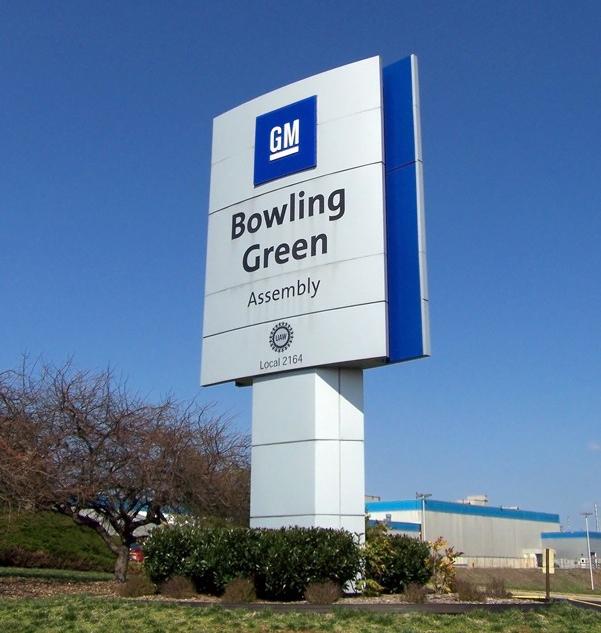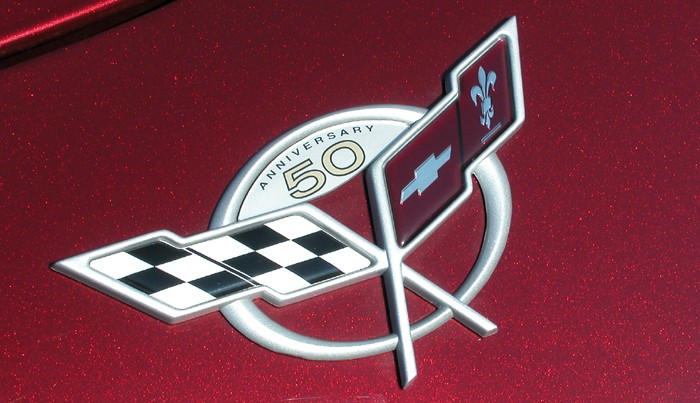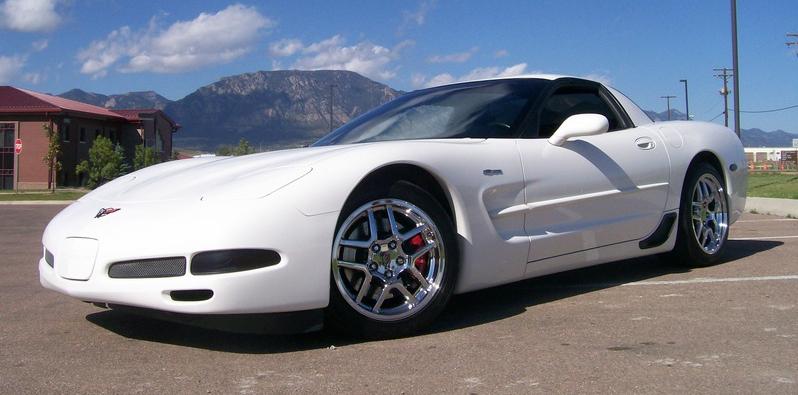Pour commencer, un peu d'histoire (si vous n'aimez pas la lecture… sautez ce chapitre)
 C5 (1997-2004) Soit 7 années de production. C5 (1997-2004) Soit 7 années de production.
La production de la C5 a commencée en 1997 et c'est terminée avec le modèle 2004. La C5 fut un tournant majeur dans l'histoire de la Corvette. La transmission a été déplacée à l'arrière de la voiture pour former un groupe compact, connecté au moteur par un arbre de transmission longitudinal. Fini les principaux défauts de la C4. La nouvelle Corvette C5 fut accueillie par la presse comme la meilleure Corvette jamais conçue, la première à rompre avec les défauts de conception du passé .
La C5 arrive avec le tout nouveau small block LS1. Cette troisième génération est complètement nouvelle, incluant notamment un allumage sans distributeur et un nouvel ordre d'allumage. D'une puissance initiale de 345HP à 5400 tr.min (257 kW) et 350 ft·lbf a 4200 tr.min (470 N·m) de couple, il vu sa puissance augmenter à 350 HP à 5400tr.min (260 kW) et 375 ft·lbf à 4200tr.min (518 N·m) de couple en 2001.


En 1997, pour sa première année, la C5 n'était disponible qu'en coupé, même si la nouvelle plate-forme a été conçue dès le départ pour être une convertible. Le convertible arrive dans la gamme en 1998, suivit par le prédécesseur de la Z06, à toit fixe et coupé (FRC), en 1999.
Le 50ème anniversaire de la Corvette a été célébré le 20-21 juin 2003 à Nashville dans le Tennessee. Ce fut un déluge de Corvettes parfaitement restaurée. Plus de 10000 Corvette ce sont réunis au Musée
National Corvette à Bowling Green dans le Kentucky.
Tous les millésimes de la Corvette étaient représentés. Il y eu même des séminaires sur l'ingénierie et la restauration des Corvettes. Les participants ont également été invités à visiter l'usine située en face du musée. Avec des visites spéciales, non prévues prévues pour le grand public. Également sur place plusieurs Corvette de course , y compris la Corvette SS construit par Zora ARKUS-Duntov et la C5-R qui a remporté Le Mans, dans sa catégorie. Parmi les nombreux exemples ont été affiche de 2003 50th Anniversary Edition ainsi que quelques 2004 commémorative édition et Indy Pace Car. Récemment, l'usine a été agrandie pour construire la Cadillac XLR cabriolet, qui partage sa plate-forme avec la sixième génération de Corvette. Bowling Green est également le berceau du musée de la Corvette, qui célèbre cette icône automobile américaine en affichant dans l'ordre chronologique les différents modèles de production, ainsi que certains modèles uniques créés par Chevrolet. Bowling Green est également le lieu du "National Corvette Homecoming", un grand rassemblement annuel des Corvettes et leurs propriétaires.
The building in Flint in which the first cars were assembled was spun off with GM's Delphi Electronics division and later donated to GMI/Kettering University in the late 1990s. The building has since been remodeled and is now the C.S. Mott Engineering and Science Center, housing the Mechanical Engineering and Chemistry programs. In the garage housing the school's Society of Automotive Engineers (SAE) club is a plaque commemorating it as the place where the first Corvette was built.
C5Z06 (2001-2004)
 A successor to the FRC C5 made its debut in 2001 as the Z06, a nod to the high performance Z06 version of the C2 Corvette of the 1960s. The Z06 models replace the FRC hardtop (1999-2000) models as the highest performance C5 Corvette. Instead of a heavier double-overhead cam engine like the ZR-1, the Z06 used an LS6, a high-output version of the standard LS1 Corvette engine producing 385 hp (287 kW). Although the Z06's total power output was less than that of the last ZR-1's, the Z06 was lighter and therefore quicker than the ZR-1. Despite these specifications, the ZR-1 still had a higher top speed, thus maintaining its "King of the Hill" status. A successor to the FRC C5 made its debut in 2001 as the Z06, a nod to the high performance Z06 version of the C2 Corvette of the 1960s. The Z06 models replace the FRC hardtop (1999-2000) models as the highest performance C5 Corvette. Instead of a heavier double-overhead cam engine like the ZR-1, the Z06 used an LS6, a high-output version of the standard LS1 Corvette engine producing 385 hp (287 kW). Although the Z06's total power output was less than that of the last ZR-1's, the Z06 was lighter and therefore quicker than the ZR-1. Despite these specifications, the ZR-1 still had a higher top speed, thus maintaining its "King of the Hill" status.
As with the ZR-1, Chevrolet found that added power output did the Z06 little good without platform modifications to bring the rest of the car up to par. A hardtop body, upgraded suspension, larger wheels and tires, a new six-speed manual transmission, along with improved gearing and functional brake cooling ducts, all became part of the total package. The Z06 is 38 lb (17.3 kg) lighter than the previous hardtop C5 thanks to a titanium exhaust (from the catalytic converter back), thinner glass, lighter wheels, and a lighter battery. From 2002 onward, the Z06 produced 405 hp (302 kW) thanks to minor engine modifications including a more aggressive camshaft profile, lightweight sodium filled exhaust valves, stiffer valve springs, and deletion of the precats. Many dynamometer test have proven that Chevrolet underrated the engine by 20 hp (15 kW) giving it a total of 425 hp.[5]
The 2002 Z06 also received revised rear shock valving and steel links to replace plastic ones of the 2001 model. An Electron blue color replaced Speedway white. The HUD became standard, and the previous forged wheels were replaced by lighter spun cast ones. The fender Z06 badges bear "405 hp" on them. The 2003 models received special silver 50th anniversary badges and revised headliner. Later 2003 models received a more durable steel shift fork instead of aluminum.
GM claimed that 405 hp (302 kW) versions of the Z06 could make the 0-60 run in 3.9 seconds and through the quarter mile in 12.4 seconds. In the hands of experienced drivers the 2002-2004 Z06 has made 11 second passes.[5] The current quarter mile record is 11.7. The car's top speed of 176 mph (283 km/h) was achieved in 5th gear at 6,500 rpm(redline), as 6th gear was an overdrive/economy gear. It proved to be a well rounded track vehicle as well, with the ability to do more than simply accelerate. Thanks in part to its upgraded suspension system, the Z06 is capable of holding its own against contemporary versions of the Dodge Viper, Ford Mustang Cobra R, and even the Porsche 911 around a road track.
The 2004 Z06 Commemorative Edition came with a carbon fiber hood which saved some weight and also received polished aluminum wheels. In addition it was equipped with a Nürburgring-tested suspension tuning to improve handling, along with an exclusive Le Mans blue color.
C5-R
 The C5-R racer was built by Pratt & Miller for GM Racing. It was based on the C5 road car but had a longer wheelbase, a wider track, an enlarged engine and more aerodynamic bodywork with a rear wing and exposed headlamps. It took part in the American Le Mans Series in the GTS Class and competed in five 24 Hours of Le Mans races as a Corvette Racing entry. The C5-R racer was built by Pratt & Miller for GM Racing. It was based on the C5 road car but had a longer wheelbase, a wider track, an enlarged engine and more aerodynamic bodywork with a rear wing and exposed headlamps. It took part in the American Le Mans Series in the GTS Class and competed in five 24 Hours of Le Mans races as a Corvette Racing entry.
* 1999 The car's debut racing season. Initially it was powered by a 6000 cc version of the 5700 cc Corvette V-8 engine but after four races the engine capacity was increased to 7000 cc.
* 2000 The car's first victory and first year at Le Mans.
* 2001 The racing season produced eight victories in ten races, including an overall win in the 24 Hours of Daytona and a 1-2 finish in the GTS class at Le Mans.
* 2002 In 2002 the C5-R repeated its 1-2 victory in the GTS class at Le Mans and also dominated the GTS class in the American Le Mans Series. A new transaxle unit replaced the previous year's separate transmission and differential. Corvette faced stiff domination from the new Privateer Non-Ferrari backed Prodrive-built Ferrari 550, which led many laps at Le Mans, but the Ferraris suffered problems late in the race, resulting in another Corvette GTS class victory.
* 2003 In 2003, the Automobile Club de l'Ouest placed additional restrictions on all 24 Hours of Le Mans competitors, reducing power by 10% in an attempt to slow the cars. At the 2003 season-opening 12 Hours of Sebring, the C5-Rs remained in winning form, with one of them finishing first in class and eighth overall. Also in 2003 a special red, white, and blue color scheme was introduced to celebrate the Corvette's 50th anniversary. At Le Mans the Prodrive Ferraris took first place and spoiled the anniversary and GM's effort for a three-peat in the GTS class.
* 2004 The C5-R was again victorious in the GTS class at the 24 Hours of Le Mans. One of the Privateer Prodrive Built Ferraris led most of the race. About halfway into the event, both Prodrive cars suffered mechanical problems, causing them to pit and lose laps. The Corvettes went on to finish 1-2 in their class.
In 2005, the factory Corvette Team began racing the C6.R to coincide with the new sixth generation (C6) Corvette being released to the public. Private teams, primarily in Europe, continued to race the C5-R.
* 2005 In the FIA GT Championship, the GLPK-Carsport team won races at Imola, Italy and Zhuhai, China, and finished on the podium on several occasions. In the ALMS, Pacific Coast Motorsports scored several podium finishes behind the new factory C6-R cars. SRT fielded a C5-R in the Belcar series in Belgium, and PSI Experience did the same in the FFSA GT Championship in France.
* 2006 The C5-R returned to Le Mans for the first time as a non-factory entry, run by Le Mans regular Luc Alphand. It finished 3rd in the GT1 class behind the C6.R and Prodrive Aston Martin. C5-Rs were run in Belcar and FFSA GT once more.
* 2007 GLPK-Carsport and SRT run C5-Rs in FIA GT, while Luc Alphand runs a Corvette for the Le Mans Series and 24 Hours of Le Mans.

|